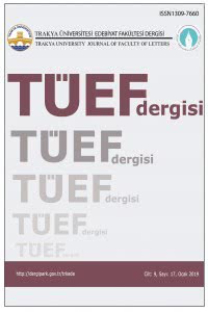Yakindoğu Arkeolojisinde Kudurrular ve İşlevleri Üzerine Bir Değerlendirme
Kudurru, Arazi Bağışı, Lanet, Kassit, II. İsin
An Evaluation on Kudurrus and Their Functions in Near East Archaeology
Kudurru, Land Donation, Curse, Kassit, Isin the Second,
___
- AKKUŞ MUTLU, Suzan (2014), “Eski Mezopotamya’da Beddua ve Felaketlerden Koruma Ritüelleri”, Gümüşhane Üniversitesi Sosyal Bilimler Dergisi, 9, 278-293.
- BELSER, Carl Wilhelm (1891), Die Babylonische Kudurru-Inschriften: III Rawl 41-45, Nach Den Originalen Umschrieben Übersetzt und Erklart Nebst Dem Zum Ersten Mal veröfeentlichten Text, Leipzig.
- BLACK, Jeremy ve GREEN, Anthony (1998), Gods, Demons and Symbols of Ancient Mesopotamia, The British Museum Press, Bath.
- BRINGMANN, John A (1980-1983), “Kudurru”, Reallexikon der Assyriologie und Vorderasiatischen Archäologie, Bd. 6, Berlin-New York, 267-274.
- BUCCELLATI, Giorgio (1994), “The Kudurrus as Monuments”, Ed. Hermann Gasche, Cinquante-deux reflexions sur le Proche-Orient ancien: Offertes en hommage a Leon de Meyer, Mesopotamian History and Environment, Occasional Publications, Vol. 2. Peeters Publishers, Louvain, 283-291.
- FALES, Frederick Mario (1990), “The Rural Landscape of the Neo-Assyrian Empire: a Survey”, State Archives of Assyria Bulletin, IV.2, 81-142.
- GELB, Ignace J., STEİNKELLER, Piotr ve WHİTİNG JR, Robert M (1991), Earliest Land Tenure Systems in the Near East: Ancient Kudurrus, The University of Chicago Oriental Institute Publications, Vol. 104, Chicago, Illinois.
- HILL, Andrew E (1988), “The Ebal Ceremony as Hebrew Land Grant?”, Journal of the Evangelical Theological Society, 31.4, 399-406.
- HINKE, William John (1911), Selected Babylonian Kudurru Inscriptions, Semitic Studies Series Vol. XIV, Leiden: E.J. Brill, New York.
- IWANISZEWSKI, Stanislaw (2003), “Archaeoastronomical Analysis of Assyrian and Babylonian Monuments: Methodological Issues”, Journal for the History of Astronomy Vol. XXXIV, 79-93.
- L. W. KING, M.A (1912), Babylonian Boundary-Stones and Memorial-Tablets in the British Museum, Printed by Order of the Trustees, London.
- LEE, Rob., JONATHAN, Philip. ve ZİMAN, Pauline (2010), “A Response to Richard Sproat on Random Systems, Writing, and Entropy”, Computational Linguistics, 36.4, 791-794.
- LIVINGSTONE, Alasdair (2006), “A Neglected Kudurru or Boundary Stone of Marduk-Nādin- Ahhē”, Revue d’assyriologie et d’archéologie Orientale, 100, 75-82.
- MANDACI, Ebru (2016), “Arkeolojik ve Yazılı Kaynaklar Işığında Eski Mezopotamya Toplumlarında Büyü ve Büyücülük”, Dicle Üniversitesi Sosyal Bilimler Enstitüsü Dergisi, 8.16, 217-232.
- NEMET-NEJAT, Karen Rhea (1998), Daily Life in Ancient Mesopotamia, California: Greenwood. OATES, Joan (2004), Babil, Çev. Fatma Çizmeli, Arkadaş Yayıncılık, Ankara.
- ORNAN, Tallay (2005), The Triumph of the Symbol: Pictorial representation of Deities in Mesopotamia and the Biblical Image Ban. Fribourg, Switzerland / Göttingen, Germany: Academic Press/ Vandenhoeck Ruprecht.
- PAULUS, Susanne (2006), “Kudurru-Göttlicher Schutz für Königliche Geschenke, Untersuchungen zu einer Mesopotamischen Denkmä/Ergattung des 2. Jt. v. ehr.”, Originalveröffentlichung in: Conrad: ein Magazin von Alumni für Alumni 2, Münster, 26-29.
- PAULUS, Susanne (2013), “The Limits of Middle Babylonian Archives”, Ed. Michele Faraguna, Archives and Archival Documents in Ancient Societies: Legal Documents in Ancient Societies IV, Trieste 30 September - 1 October 2011, Trieste, EUT Edizioni Università di Trieste, 87-103.
- PAULUS, Susanne (2017), “The Babylonian Kudurru Inscriptions and Their Legal and Sociohistorical Implications”, Ed. K. Sternitzke, A. Bartelmus, M. Roaf, Karduniash, Babylonien zur Kassitenzeit. Babylonia under the Kassites 1, Untersuchungen zur Assyriologie und Vorderasiatischen Archäologie, De Gruyter, München, 229-244.
- PIZZIMENTI, Sara (2014), “The Astral Family in Kassite Kudurrus Reliefs. Iconographical and Iconological Study of Sîn, Šamaš and Ištar Astral Representations”, Ed. Lionel Marti, La famille dans le Proche Orient ancien: réalités, symbolismes, et images. Proceedings of the 55th Rencontre Assyriologique Internationale at Paris, 6-9 July 2009, Winona Lake, Eisenbrauns, 151-161.
- READE, Julian (2009), “Fez, Diadem, Turban, Chaplet: Power-Dressing at the Assyrian Court”, Ed. Mikko Luukko, Of God(s) Trees, Kings and Scholars, Neo-Assyrian and Related Studies in Honour of Simo Parpola, Finnish Oriental Society, 239-264
- ROGERS, John H (1998), “Origins of the Ancient Constellations: I. The Mesopotamian Traditions”, British Astronomical Association, 108.1, 9-28.
- SEIDL, Ursula (1989), Die babylonischen Kudurru-Reliefs: Symbole Mesopotamischer Gottheiten (Orbis Biblicus et Orientalis 87), Freiburg, Switzerland/Göttingen, Germany: Universitätsverlag/Vandenhoeck Ruprecht.
- SLANSKI, Kathryn E (2000), “Classification, Historiography and Monumental Authority: The Babylonian Entitlement Narûs (Kudurrus)”, Journal of Cuneiform Studies, 52, 95-114.
- SLANSKI, Kathryn E (2003), The Babylonian Entitlement Narûs (Kudurrus): A Study in Their Form and Function, Journal of the American Oriental Society, 124.4, American Schools of Oriental Research, Boston.
- STEINKELLER, Piotr (2011), “Ancient Kudurru, Inscriptions”, Ed. A.R. George, Cuneiform Royal Inscriptions and Related Texts in the Schøyen Collection, The publication of Cornell University Studies in Assyriology and Sumerology, 17, Bethesda, Maryland, 211-220.
- STEYMANS, Hans Ulrich (1995), Deuteronomium 28 und die ade zur Thronfolgeregelung Asarhaddons, Orbis Biblicus et Orientalis 145, Segen und Fluch im Alten Orient und in Israel, 145.
- WESZELI, Michaela (2010), “A New Boundary Stone of the Reign of Nabû-mukīn-apli (978-943 BC)”, Revue D'Assyriologie et D'Archéologie Orientale, 104, 99-130.
- WHEAT, Elizabeth Ruth Josie (2012), Terrestrial Cartography in Ancient Mesopotamia, A Thesis Submitted to the University of Birmingham for the Degree of Doctor of Philosophy.
- ISSN: 1309-7660
- Yayın Aralığı: 2
- Başlangıç: 2011
- Yayıncı: -
Makedonya 1900’de Adalet ve İntikam Arayışı
Medineli Yahudi Şair Ebû ‘Afek ve Tahrîd (Kışkırtma) Şiiri
BİLGE CATO’NUN SİYASİ KARİYERİNDE PATER KAVRAMININ ÖNEMİ
GÜLSELİ İNAL’IN ŞİİRLERİNDE İMGE VE MİTOLOJİ İLİŞKİSİ
Çalışma Hayatında Ötekileştirilmeye İlişkin Roman Kadınların Görüşleri: Nitel Bir Çalışma
Sevcan FAZLA, İlke ORUÇ, Deniz Mertkan GEZGİN
VİLDAN SERDAR’IN İKİ ROMANI: SABAHSIZ GECE İLE AŞK VE GÖÇ’ÜN ELEŞTİRİSİ
MAKEDONYA 1900’DE ADALET VE İNTİKAM ARAYIŞI
Gülseli İnal’ın Şiirlerinde İmge ve Mitoloji İlişkisi
